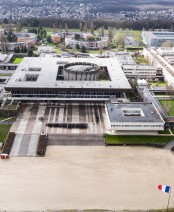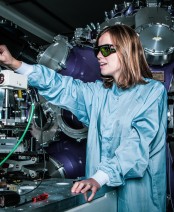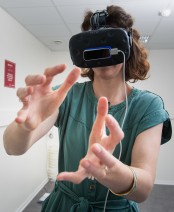ERC Synergy: Antarctic Climate and the Role of the Hippocampus in the Brain

 Photo credit: left: NASA - GSFC Scientific Visualization Studio Antarctica; right: images of colored neurons observed by the collaboration of the Institut de la Vision and the Laboratory of Optics and Biosciences.
Photo credit: left: NASA - GSFC Scientific Visualization Studio Antarctica; right: images of colored neurons observed by the collaboration of the Institut de la Vision and the Laboratory of Optics and Biosciences.
In order to be achieved, some research projects are too ambitious to be carried out by an individual researcher and require funding over a longer period of time than traditional research grants. To meet this need and explore new perspectives, the European Research Council (ERC) has set up a very selective program to fund some thirty projects each year submitted by groups of 2 to 4 researchers and their research teams.
This year, École Polytechnique is proud to participate in two prestigious projects selected: the Laboratory of Dynamic Meteorology (LMD*) is involved in the AWACA project, whose objective is to understand the water cycle in Antarctica through a combination of measurements and modeling, and the Optics and Biosciences Laboratory (LOB*) is involved in the HOPE project, which aims to shed a unique light on the cerebral function of the hippocampus by studying the construction of its circuits using innovative imaging techniques.
AWACA
The Antarctic ice sheet is the largest fresh water reservoir on Earth. The Antarctic contribution to sea level results from the small imbalance between the snowfall amount accumulating on the continent and an ice flux of the same magnitude discharging into the ocean.
Correctly representing atmospheric circulation, the physics of water phase change and transport in models is paramount to correctly simulate snow precipitation and accumulation over the Antarctic ice sheet and ultimately the akin sea-level rise. This is the challenge that the AWACA project seeks to address.
Christophe Genthon, CNRS Research Director and Thomas Dubos, École Polytechnique Professor, both from the Laboratory of Dynamic Meteorology (LMD*), Valérie Masson-Delmotte, Research Director at the French Alternative Energies and Atomic Energy Commission and contributor to several IPCC reports, and Alexis Berne, Associate Professor at the Environmental Remote Sensing Laboratory at EPFL, gather recognized expertise in key domains regarding this ambition: observation, analysis, experience in field work, and atmospheric numerical modeling.
They aim to deploy specifically designed instruments to observe atmospheric water, coupled with new physics parameterizations for climates models. This combined expertise will enable them to characterize and simulate the atmospheric water cycle over Antarctica as a whole and not in parts (e.g. from a dynamic or microphysical or isotopic perspective) as was done so far, in order to revisit past climate variability and better predict future climate conditions over Antarctica.
> Learn more : A 1,100-km project to understand Antarctica's atmospheric water
Learn more about the Antarctic falls:
https://www.youtube.com/watch?v=42lM1TSAS2M&list=PLyF1e3UM69vLNa9ZStiqH…
HOPE
Inside our brain, a certain structure plays a key role in memory, and more particularly in the acquisition and holding of our memories: the hippocampus. Classically considered as a "cognitive GPS" for space and time, it also provides our episodic memory.
Over the last decade, the neural circuits of the hippocampus have been better described, in particular by Rosa Cossart, Director of the Institut de neurobiologie de la méditerranée (Inmed), and her team, but the nature, origin, and remodeling of these units of circuitry during development and pathology remain elusive.
On the other hand, genetic engineering techniques to color neurons, developed by Jean Livet, Inserm Research Director at the Institut de la Vision, coupled with multiphoton microscopy developed by Emmanuel Beaurepaire, CNRS Research Director at the Optics and Biosciences Laboratory (LOB*) have demonstrated their ability to accurately map the complex architecture of neural circuits and their evolution during development.
By combining these exceptional multidisciplinary advances, HOPE aims to answer three interrelated questions:
- Are adult hippocampal assemblies shaped by specific circuits?
- Are they prewired or shaped by experience?
- How does this structure reorganize itself in pathological conditions?
HOPE aims to shed a new light on the function of the hippocampus and the role of its neural circuits through the design of a novel, non-invasive and universal method to trace the growth and construction of deep brain circuits, from neurogenesis to adulthood, in health and disease.
Learn more about one of the microscopy techniques of this project:
https://www.youtube.com/watch?v=jRWqVYBaoAs
*LMD: A joint research unit CNRS, École Polytechnique, ENS/PSL and Sorbonne Université ; LOB: A joint research unit CNRS, École Polytechnique, Inserm








